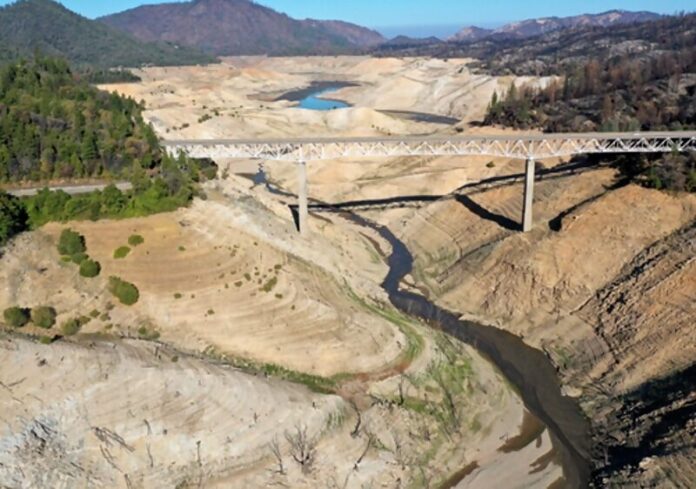Increasingly being described as a national disaster in the making, the US Southwest, and in particular, California, face a future that may be a replay of the Dust Bowl of the 1930s as a continuing megadrought does its worst. It’s not just the fact that Southern Californians are having their home water taps shut to a trickle because so many continue to ignore mandatory water restrictions. It’s also because of growing levels of dust in the air as winds pick up the bone-dry soil. Already New Mexico and Arizona are experiencing Dust-Bowl-like windstorm events. These plus the growing danger of wildfire outbreaks has the entire US Southwest on high alert. Meanwhile, the lifeline of the region, the Colorado River, has been drained to near death as evidenced by declining water levels in both Lake Powell and Lake Mead.
The cities of the southwest, Los Angeles, Phoenix, Las Vegas, and Tucson, are all facing an existential crisis. Yet despite this, Las Vegas continues to grow in population. It’s like watching moths attracted to a flame or lemmings collectively going blindly off a cliff.
The existential crisis isn’t limited to cities. Agriculture is in peril. The farmers of the southwest are used to drought, but not to this drought. In California, farmers have been drilling wells to tap groundwater for decades and usually found enough to top their needs over and above surface water delivery from California’s extensive canals and reservoirs. But now those underground reservoirs guaranteed to produce at 300 metres in depth are dry. Surface land in some areas is subsiding by as much as a half metre per year as underground water sources are further depleted.
What this means for the price of food is reflected in grocery stores today. It’s not just the disruption of the food supply by a war of aggression launched by Russia that is the cause, but rather the megadrought affecting America’s prime growing region. According to California’s Department of Food and Agriculture, it produces more than one-third of vegetables and two-thirds of the fruit and nuts grown and consumed in the US and Canada.
Farmers with almond orchards, considered water hogs, to say the least, may soon find themselves cutting them down and replacing them with drought-resistant crops. The same is true for avocadoes and other fruit and nut cash crops that California produces in abundance.
Just how abundant you ask? When my wife and I were invited to a wedding in California three years ago we turned it into a vacation drive up the coast. We past avocado stands by the dozens. Farmers were producing avocadoes in such surplus, they were selling them for $0.99 a dozen. Yesterday, when I ordered my groceries, avocadoes in Toronto were selling for more than $2.00 apiece.
Megadroughts Have Happened Before
A megadrought in the American Southwest isn’t something that hasn’t happened before. Past episodes are evident in the record of the native inhabitants. The Anasazi were a cliff-dwelling culture that occupied an area that includes Utah, northeastern Arizona, northwestern New Mexico, and southwestern Colorado. They vanished after hundreds of years because of prolonged drought.
But unlike the Anasazi, modern, technologically advanced civilizations can find ways around what nature doesn’t provide. The tapping of the Colorado River is but one example. Harvesting groundwater is another.
Then there is desalination of ocean water. This has been hotly debated in California for more than twenty years. A proposed $1.4 billion desalination zero-carbon producing plant in Huntington Beach going by the name, Poseidon, was last month rejected by the state’s Coastal Commission. The reason given was the plant’s multi-decade destructive impact on coastal marine life.
Another ingenious project is once more being resurrected to flood a valley north of Sacramento, the state’s capital. The idea was first proposed seventy years ago during a drought and has been rejected repeatedly through numerous dry spells in the state’s history. But the megadrought is driving renewed interest.
What would it involve? It requires the building of two large and nine small dams to create a stormwater reservoir in a valley adjacent to the Sacramento River. The estimated project cost is $4 billion. The valley in question is described as a “great dusty bowl 13 miles long and about 5½ miles wide where cattle and deer browse grasslands framed by oaks and creeks that go dry in the brutal heat of summer. It’s also home to 20 people.”
Water would be diverted to the reservoir created by the dam through existing canals and one new pipeline. The plan would be designed to not block the Sacramento River channel itself or impede migratory fish that inhabit it. It would store a maximum of 1.5 million acre-feet of water for farm and urban use. An associated tunnel would convey water to Southern California cities and San Joaquin River valley farms. If approved by 2024, it would become fully operational by 2030. The Sacramento River it would tap is already experiencing lower water flow levels after three years of little rainfall and less than normal winter runoff from the Sierra Nevada Mountains that feed it. What the river’s condition will be by 2030? Likely much worse if the megadrought persists.
Although 1.5-million-acre-feet of water sounds like a lot, compared to California’s current water demand which equals 42-million-acre-feet annually, it amounts to a mere 3.5%. So this project does little to address what is being imposed increasingly on the state because of drought. And as the entire southwest continues to get drier the reservoir the project creates would soon turn into another diminishing freshwater resource like Lake Oroville pictured above, or the Colorado River’s Lake Powell and Lake Mead.










[…] the way we build it today, a solution to the rising salt line? In California, a proposed desalination plant at Huntington Beach near Los Angeles was recently voted down by the state’s coastal commission. The primary […]